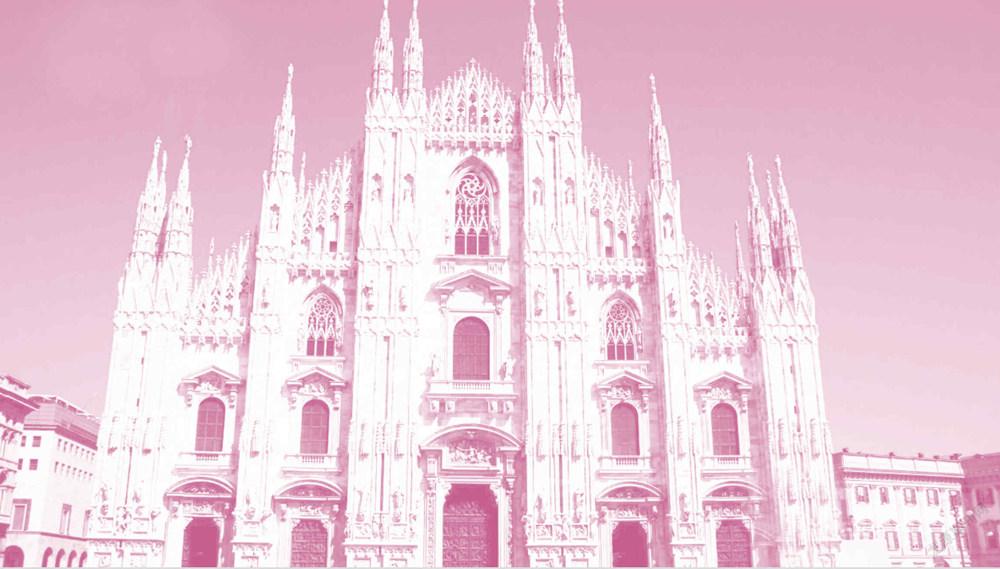文艺复兴时期的继往开来







Backward and Forward
By V. M. Hillyer
——V. M. 希利尔(仲秋 译)
V. M. 希利尔(1875—1931),美国著名儿童教育家、科普作家,创建了卡尔弗特教育体系。他为孩子们编写了一套趣味盎然的历史、地理、艺术读物,即《写给孩子看的世界历史》《写给孩子看的世界地理》《写给孩子看的艺术史》。本文选自《写给孩子看的艺术史》,该书写于20世纪二三十年代。
In 1492 Columbus discovered America. Everyone knows that date. And so it is easy to remember when Renaissance architecture began in Italy. It was in the same century as 1492, the fourteen-hundreds. Some of the earliest Renaissance buildings of the fourteen-hundreds are the best. The picture below is a picture of the Riccardi Palace in Florence. It looks more like a fort than a palace and that is what it really was on the outside—a fort.
There was so much fighting going on that these palaces in Florence had to be built like forts. Notice the iron bars on the lower windows. Notice the heavy rough stones in the lower story. That kind of stone-work is called “rusticated”. The stones bulge out from the joints between them. This makes the building look strong and solid.
The top of the building is crowned by a ledge that sticks out all around the wall. Such a ledge is called a cornice. The cornice kept the building from looking like a plain box. The cornice finished off the top of a building just the way a capital finished off the top of a column. The windows have round arches, not pointed like Gothic.
The building is more like a palace inside than outside. In the middle of the inside is an open courtyard which has balconies around it. There is a big banqueting hall, a library, and other finely furnished rooms. This Renaissance building is called the Riccardi Palace because Riccardi was the name of the family who bought it from the Medici family who built and lived in it first.
1492年,哥倫布“发现”了美洲大陆。这个年份大家都很熟悉。文艺复兴式建筑在意大利兴起的时间也很容易记住,因为它与哥伦布“发现”美洲大陆的1492年在同一个世纪,那就是15世纪。15世纪早期的一些文艺复兴式建筑是所有文艺复兴建筑中最优秀的。下图是佛罗伦萨里卡迪宫的一角。虽然是宫殿,但从外面看上去它更像一座堡垒,事实上它的外侧也的确曾被作为碉堡使用。
那时的佛罗伦萨陷入战火之中,所以宫殿也全都砌成碉堡的样子。看看那些被粗粗的铁条封起来的下层窗户吧,再看看那些厚重、结实的石块加固的底层基座就明白了。底层基座所使用的石块被称作“粗面砌筑”。粗面砌筑的工艺,是让每个大石块与连接处相比较都稍稍地向外凸隆,这样可以使得整栋建筑看上去牢固、坚实。
在建筑顶部的墙壁周围,有一圈突出的岩脊,这种岩脊叫作“上楣”或者“飞檐”。因为有了这种像是装饰镜框似的上楣,整座建筑看起来就不会只像一个四四方方的、单调的盒子了。墙顶上飞檐的作用与圆柱顶上柱头的作用是十分类似的。这座建筑的窗户是圆顶式的,与哥特式建筑中的尖拱不同。
建筑的内部,就比外部更加像一座宫殿了。建筑内部的中央,是一个露天的庭院,周围有阳台。建筑里有大的宴会厅、图书馆,还有许多装饰精美的房间。这座文艺复兴风格的建筑,是由美第奇家族修建并第一个居住的,但是它后来被里卡迪家族买下,所以称为“里卡迪宫”(又有人称之为“美第奇—里卡迪宫”)。
And now is a good time to notice a great big difference between Gothic and Renaissance buildings. In Gothic buildings most of the lines are up and down. The eye is carried from the ground straight up to the top of the building. But in Renaissance buildings most of the lines are lengthwise—horizontal. In the Riccardi Palace your eye notices the horizontal lines of stones, the windows all in line, the horizontal ledges under the windows, and the long, straight cornice.
Several famous Renaissance architects followed Brunelleschi. One, named Bramante, made a plan for a great cathedral to be built in Rome for the Pope. It was to be the largest church in the world. And was to be called St Peter’s. But Bramante died before much work had been done. Several other architects worked on this big building, until it was finally given into the care of the mighty Michelangelo, who was the greatest Renaissance sculptor as well as a great painter, poet, and wonderful architect.
Michelangelo was an old man, but he pushed the work forward on St Peter’s so that it was almost finished at his death. Michelangelo’s plan was to have the church built in the form of a Greek cross, with a magnificent dome over the middle.
現在,是时候注意一下哥特式建筑和文艺复兴式建筑的重要区别了。哥特式建筑中,其使用的大部分线条都是纵向的,这样的设计可以使得视线直接从地面拉伸到屋顶,是一种向上延伸的设计。但是在文艺复兴式建筑中,大部分线条都是横向的,也就是水平的。你看,里卡迪宫中所有的石块都水平陈列,所有的窗户都在一个水平线上,窗台隔开的每一层也是整齐地横向排列,还有最顶端突出环绕着一圈笔直的上楣雕饰。
在建筑师菲利波·布鲁内莱斯基之后,又出现了一些著名的文艺复兴时期建筑师,其中有一位名叫多纳托·伯拉孟特,他曾经给一座伟大的大教堂做设计,这座大教堂当时是准备为罗马教皇修建的。伯拉孟特本来计划把这座教堂修建为世界上最大的一座教堂,并且命名为圣彼得大教堂。但可惜的是,开工没多久他就去世了。伯拉孟特之后,又有其他几位建筑师参与这座巨大建筑的设计和修建工作,最后,非凡的米开朗琪罗全权负责了这座建筑的建设。米开朗琪罗是文艺复兴时期最伟大的雕塑家,也是伟大的画家、诗人,同时还是杰出的建筑师。
虽然米开朗琪罗负责这项工作的时候已是高龄,但是他对圣彼得大教堂建设的推进工作十分有力,在他去世的时候这座建筑已经基本完工了。米开朗琪罗的计划是把这座教堂建成希腊式十字形,中厅的上方是一个华丽宏伟的圆拱。
Word Study
ledge /ledʒ/ n. 悬崖岩石突出部;岩架
banqueting /'bæŋkwɪtɪŋ/ adj. 宴会的
furnished /'fɜːnɪʃt/ adj. 配备家具的
The house was simply furnished.
cathedral /kə'θiːdrəl/ n. 主教座堂;教区总教堂
sculptor /'skʌlptə(r)/ n. 雕刻家;雕塑家
He turned his artistic gifts to good account by becoming a sculptor.
Michelangelo made everything about St Peter’s so tremendously large that the cathedral doesn’t look as large as it really is. That sounds funny, I know. You’d think the bigger a thing was, the bigger it would look. That isn’t always so. It depends on something called scale. If you take a photograph of a tree, you can’t tell from the photograph how big the tree is unless there is a man or a dog or a house or something near the tree to give you some way of measuring. It is the same with a map: you can’t tell whether a town is thirty miles away or three hundred miles unless there is a scale to measure by.
The windows of St Peter’s are about four times as tall as a man. So unless you see a man near them you would naturally think they were about four times as small as they are, because most windows are about as tall as one man. That is the great trouble with St Peter’s. It lacks scale.
Long after Michelangelo had died, another architect added a new front to the cathedral, and this cut off the front view of Michelangelo’s wonderful dome. This architect also made the church a Latin cross by extending the front. Then still later another man named Bernini added two colonnades, or rows of columns, to the front. These rows of columns are built around two sides of a great circular open space out in front of the cathedral.
The colonnades by Bernini are beautiful, but they haven’t anything to help us judge their size by any more than the cathedral has. They lack scale, just as the cathedral itself lacks scale. Look very closely at the picture and you will see some people in the square. When you measure the cathedral by them, you get some idea of how big it really is.
圣彼得大教堂驚人的巨大,但看上去却感觉很小,这是因为米开朗琪罗将整座建筑的一切都放大了。这听起来很好笑?我知道你肯定认为大的东西看起来也会大,小的东西看上去才会小,但事实上却不是这样的。一个东西看上去是大还是小是由周围事物比较而定的。比如,如果给你看一张只有一棵树的照片,你肯定看不出来这是棵大树还是小树;但是如果离树很近的地方还有一个人、一只狗或者一栋房子,就可以让你用来作为参照物估计树的大小了。地图也是如此,如果没有一个丈量的比例——也就是我们常说的比例尺,从地图上你也很难看出某个地方离你是30英里还是300英里。
圣彼得大教堂的窗户大约有四个人那么高。因此除非有人正好在窗户旁,否则,当你从远处看时,会自然地感觉这些窗户只有它们实际大小的四分之一,因为平常看见的大部分窗户都只有大约一个人那么高。总而言之,缺少参照物是圣彼得大教堂看上去显得小的一个重要原因。
在米开朗琪罗去世很久以后,有位建筑师对圣彼得大教堂进行增添,他给这座大教堂新添加了正面建筑,不过这样一来就把原本米开朗琪罗修建的漂亮的圆顶穹隆的正面视线切断了。这位建筑师还把正面的建筑加长,把这座教堂修改成了拉丁式十字形。后来,教堂前面的环形空地上,被一位名为济安·贝尼尼的建筑师加建了两排柱廊,这两排柱廊就依着空地的环形边缘而建。
济安·贝尼尼修建的柱廊非常好看,但是和大教堂一样,柱廊也缺少参照物,因此光看柱廊你很难知道它们的大小。仔细看下方的这幅图,你可以看到柱廊环抱的广场上有一些人,如果你用这些人来作为参照物,应该就能看出来这个大教堂到底有多庞大了。
Look at the plan of St Peter’s, showing the cathedral itself and, at the top of the plan, the arrangement of the Bernini colonnades.
Gothic columns were never very much like Roman columns. But the Renaissance architects used the Roman capitals on the columns of their buildings. Sometimes they even pulled down Roman buildings and used the columns for new Renaissance buildings. Notice, too, the columns, which are like Roman columns.
There were many famous Renaissance architects in Italy and they have left many famous buildings, but we’ll have to skip over some of them to tell you about a man named Palladio. Palladio made famous a special use of columns. The columns run from the ground up past two or three stories. This is called the Palladian style, because Palladio wrote a book about it which architects in other countries as well as in Italy found very useful. The front of St Peter’s shows columns running past two stories.
Renaissance architecture spread from Italy to other countries and has been used ever since. All styles of architecture grow out of earlier styles. The Renaissance architecture grew by looking backward toward Rome, but its use came at a time when the world was looking forward to greater things. Explorers, scientists and thinkers were showing the way to modern times, though they were getting some of their ideas from studying ancient ways. They were looking backward but moving forward.
看到圣彼得大教堂的平面图了吧?这个平面图展示了整个大教堂本身的结构。在平面图的最上面,展示的就是济安·贝尼尼修建的柱廊的排列方式。
哥特式建筑的柱式完全不同于罗马式建筑的柱式,但是文艺复兴时期的建筑师在他们的建筑物廊柱上使用罗马式廊柱的柱头。有时候他们甚至将原来的罗马式建筑拆掉,然后将拆出来的材料拿来修建文艺复兴式的建筑。你到了现场仔细看看廊柱就能看出来很像罗马柱式的风格。
文艺复兴时期,意大利有许多著名的建筑师,他们留下了许许多多有名的建筑,但是我也不能穷举了,只能跳过他们中的一些人,直接给你讲讲安德烈亚·帕拉第奥的故事吧。帕拉第奥推广了圆柱的一种特殊运用,并让它闻名于世。这种特殊的运用,就是让圆柱从地面开始向上延伸到两三层楼的高度。这种建筑风格被称作“帕拉第奥式”建筑风格。之所以被命名为帕拉第奥是因为帕拉第奥写了一本介绍这种建筑风格的书,许多意大利和其他一些国家的建筑师读了这本书之后发现这种方法非常实用,于是就流传开来。圣彼得大教堂正面的圆柱,它们的高度就是直达两层楼。
从那以后,意大利的文艺复兴式建筑风格传播到了其他国家,而且直到今天还被人继续使用。所有新的建筑风格都在旧风格的基础上继承和创新。文艺复兴式建筑风格源自罗马建筑风格,但是它的兴起,还是主要基于整个世界开拓创新的思潮。尽管探险家、科学家和思想家的一些思想来源于对前人的研究,但是,他们更加为我们现在的生活开拓了新的路径。文艺复兴式建筑的建筑师继往开来——既传承了历史,也向着未来迈进。
Word Study
tremendously /trə'mendəslɪ/ adv. 巨大地;極大地
extend /ɪk'stend/ v. 使伸长;扩大;扩展
colonnade /'kɒlə'neɪd/ n. 列柱;柱廊
circular /'sɜːkjələ(r)/ adj. 圆形的;环形的;圆的
The lamp stands on a circular base.
backward /'bækwəd/ adv. 向过去;往前
He looked backward forty years.
forward /'fɔːwəd/ adv. 向将来;往后
The next scene takes the story forward five years.
1096501705387

